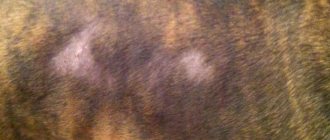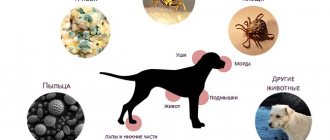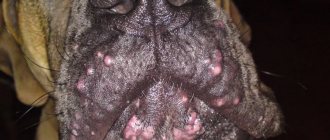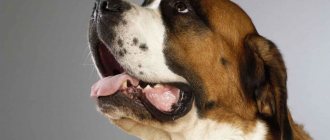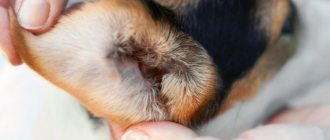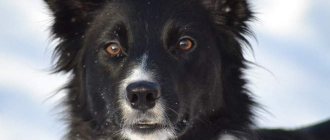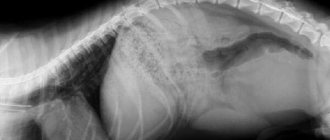Causes
The causes of a dry and hot nose are not always serious illnesses, but the occurrence of cracks against the background of an inflammatory process indicates the presence of serious health problems. This is a kind of signal that appropriate measures need to be taken urgently. If the skin on a dog's nose is cracking , this can be caused by the following factors:
- Heredity and age-related changes. A warm nose is a common occurrence for most puppies, and even normal for breeds with slow metabolisms.
- During sleep or immediately after waking up, most domestic dogs have a dry and warm nose. There is nothing strange in this, since the condition is quite normal. It is worth sounding the alarm if, against the background of such a distinctive feature, the animal has lost its appetite, has become lethargic, has an increase in body temperature and other signs of illness.
- Fatigue. After playing for a long time, the animal is not able to regulate body functions well, as a result of which its nose may be dry.
These causes of a warm and dry nose are natural and cannot harm the animal's health. However, cracks that occur may indicate such serious diseases as:
- Result of injury. The lining of the nose is very sensitive and can crack if hit. This causes discomfort and severe pain to the animal, because its sense of smell disappears, not only as a result of cracks in the skin, but also bruises and swelling from the blow;
- Infection. In turn, it is divided into indirect and direct. If the skin on a dog's nose is cracking , the cause may be a severe cold, a fatal disease such as distemper, or other infectious diseases. An animal can also carry bacteria and fungi onto its nose if there is an infection in its mouth or body. Infection can occur as a result of excessive curiosity. An animal can dig up sand or earth, a garbage heap, etc. As a result, inflammation and painful cracks appear;
- Elderly age. As animals age, problems with metabolic processes arise, which can cause tissue disease;
- Diseases. Liver damage, diabetes mellitus, helminthic infestation, pemphigus, allergic reaction - all these diseases can cause the nose to dry out and, as a result, cracks on it;
- Avitaminosis. In young children, as a result of a lack of vitamins in the body, cracks in the area of the fingertips may be observed. Something similar happens to a dog's nose;
- Stress. The animal’s body can react in this way to any unusual situation from its point of view.
Since there are many causes of nasal cracks, only a veterinarian can make an accurate diagnosis. Also, a specialist must prescribe treatment, because using antibiotics can not only be harmful to health, but also completely useless, for example, for mucous membrane fungus or worms.
What to do
If your dog has a cracked nose, it is important to have him examined by a veterinarian to rule out serious illness. Your veterinarian will perform a thorough physical examination of your dog's body and ask you questions regarding his medical history. For sunburn, you will be asked relevant questions about how long your dog has been in the sun, how often your dog is in the sun, and skin pigmentation. If your dog is severely sunburned, he may be given intravenous fluids to prevent dehydration. Your veterinarian may also prescribe topical antibacterial and antifungal ointments.
In the case of a pollen allergy or infection, your veterinarian will ask you questions about when your dog's symptoms begin. Your veterinarian will ask you about changes in diet or activity level to rule out other conditions. A skin scraping may be performed to rule out parasites or determine the type of infection. If your dog has a cracked nose as a result of a pollen allergy, he may be prescribed antihistamines to relieve symptoms. Your dog may also be prescribed a medicated shampoo to relieve itching and skin irritation. Other treatment options include corticosteroid injections.
Signs of pathology
If the reason why a dog's nose is cracking is pathological, then this is accompanied by the following symptoms:
- Increased dryness of the skin;
- Peeling;
- An increase or decrease in body temperature, as well as a local increase in temperature;
- Lack of appetite;
- Changes in the animal's behavior;
- Runny nose;
- The occurrence of regular scratching in the affected area;
- Vomiting, nausea;
- Problems with urination and bowel movements.
If the above signs are present, it is recommended to immediately show the animal to a doctor to identify the problem and prescribe timely treatment.
Fungal infection. Treatment of fungal infection
Fungal infection is a fairly common disease in both animals and humans. This disease is curable, however, only if the pet owner reacts to the symptoms in time and, without wasting time, seeks help from doctors. A dog can “catch” such an infection after contact with infectious dogs, or while walking on contaminated grass, where this type of fungus is a common habitat. Also, a pet can become infected with this disease due to its weakened immune system and the latter’s low resistance to various infections. There are quite a lot of factors due to which a dog can be a carrier of a fungal infection, however, their absence absolutely does not guarantee that the pet becomes unconditionally protected.
The fungus spreads quickly and affects almost all areas of the dog's body. It manifests itself in the form of spots that bring incredible discomfort to the animal. This happens because the skin on which the bald spots have formed begins to itch very much.
Treatment should be prescribed directly by a veterinarian after the results of all necessary tests. First of all, you should decide on the medications that your pet will be forced to take. Their use should not stop or weaken this infection, but destroy it once and for all.
If the disease has not had time to gain momentum, and so far only small bald spots have begun to appear on the body, then you can get by using all sorts of solutions or the following ointments: juglone, yam, mycosolone, clotrimazole. However, smearing large areas of skin where hair has fallen is quite dangerous, since the components used to combat fungal bacteria are toxic. In such cases, the dog is washed with special shampoos: imaverol, doctor, nizoral. Only external skin treatment will not be effective if drugs are administered inside the body. Such drugs can be in the form of tablets or injections: fluconazole, griseofulvin, ketoconazole. Simultaneously with such medications, the animal should be given modulators with immunostimulants, which are used to protect the liver.
Options for solving the problem
Treatment for this condition should be targeted, directly related to the cause that caused cracks in the nose. Therefore, treatment at home can not only be pointless, but also dangerous for the animal. First of all, you need to identify the cause of the disease, and based on this, the doctor will prescribe medications and procedures.
The dry surface of the nose can be lubricated with Trivit - a vitamin solution, ointments as prescribed by a veterinarian. It is necessary to exclude the possibility of injury and rubbing of this area with a muzzle, which can only aggravate the condition. In addition, the animal must be provided with peace of mind, clean conditions, a balanced diet and adhere to the full course of treatment prescribed by the veterinarian.
What diseases are the precursors of such a symptom?
A symptom such as a shabby nose can be a manifestation of the following diseases:
- Fungal infection.
- Bacterial infection.
- Burn.
- Received injury.
- Allergy.
- Impaired metabolism.
At their core, they have much in common, but treatment and prevention have many different factors that need to be paid close attention to.
Anal sac disease
As if dog poop isn't smelly enough, dogs produce a foul-smelling substance as they go about their business.
The substance comes from small anal sacs, which can become damaged if they are not emptied properly. The hallmark of impacted anal sacs is that the dog scuffs its buttocks on the ground. Other symptoms include biting or licking the anal area.
A veterinarian can manually remove complete anal sacs, but in severe cases, the sacs can be surgically removed.
Seborrhea
Seborrhea causes your dog's skin to become oily and cause flakes (dandruff). In some cases, it is a genetic disorder that begins at a young age and lasts a lifetime.
But in most dogs with seborrhea, the flaking occurs as a complication of another medical problem, such as an allergy or hormonal imbalance.
In these cases, it is vital to treat the underlying cause so that symptoms do not recur. Seborrhea itself can usually be treated with certain medicated shampoos.
Skin tumors
If you notice a lump on your dog's skin, take it to the vet as soon as possible. Dogs can develop cancerous tumors on their skin. The only way to confirm a cancer diagnosis is to perform a biopsy of the tumor.
If the tumor is small enough, your veterinarian may recommend removing it completely. This can lead to diagnosis and treatment with a single procedure.
For tumors that have not spread, this may be the only treatment needed.
Metabolic disease
Metabolic disorders in dogs occur for several reasons. This could be poor nutrition, a lack of vitamins necessary for the body, or ultraviolet radiation. This disease can cause changes and deformations of the skin, both on the face and in other parts of the animal’s body.
To stabilize and normalize metabolism, it is necessary to add the missing vitamins and minerals to the dog’s diet, or put him on a specially formulated diet, thanks to which the intake of a certain amount of carbohydrates, fats and proteins into the pet’s body will be regulated.
It is very important to respond to a new disease in a timely manner in order to prevent vitamin deficiency, nervous system disorders, obesity, damage to visual acuity, baldness, and such terrible consequences as infertility and paralysis of the limbs.
Fleas
Fleas are the bane of any pet owner. You may not see the tiny insects themselves, but flea droppings or eggs are usually visible on your dog's fur.
Other symptoms include excessive licking or scratching, scabs, and acute moist dermatitis. A severe flea infestation can cause blood loss and anemia and even expose your dog to other parasites such as tapeworms.
Treatment may include topical and/or oral flea treatment and a thorough cleaning of the animal's home and yard.
Allergy. Treatment of an allergic reaction
The manifestation of an allergic reaction can be varied and in completely different places. Since the animal’s body can react completely unpredictably to substances that are safe at first glance, you should be vigilant and provide first aid to your pet. An allergy can leave its mark not only on the internal organs of the animal, it can also affect the appearance of the pet. So, one of the manifestations is peeling of the upper cover of the muzzle.
Self-medication of allergic reactions is categorically not recommended, since to establish the reasons that caused the allergy, you will need to do a considerable number of tests, such as:
- Mycological and bacteriological cultures.
- Trichoscopy.
- Take scrapings.
- Cytological studies.
- Nutritional research.
Therefore, if you suspect an allergy, it is best to immediately contact qualified specialists.
Ticks
Ticks, like fleas, are external parasites that feed on the blood of their hosts. You can see a tick feeding on your dog with the naked eye.
To properly remove a tick, hold the tick with tweezers close to the dog's skin and gently pull it out. Twisting or pulling too hard can cause the dog's head to remain embedded in the dog's skin, which can lead to infection.
Place the tick in a jar of alcohol for a couple of days. If your pet is sick, your veterinarian may need it to analyze what's wrong.
Diseases of the nasal cavity in dogs
With diseases of the nasal cavity in dogs, the following symptoms are possible:
- Mucous discharge from the nose
- Sneezing
- Difficulty breathing through the nose
- Nosebleeds
- Deformation of the nose, visible changes in the shape of the facial part, pain on palpation of the nose area
- Tearing
The causes of nasal cavity disorders can be various diseases.
Inflammatory diseases
Lymphoplasmacytic rhinitis (LP rhinitis) is the most common inflammatory disease of the nasal cavity in dogs. This type most often occurs in middle-aged and older dogs, but it can also occur in young animals. It is not known why some dogs suffer from this type of inflammatory disease and others do not. When examined with modern imaging techniques (such as CT or MRI), diseases of the nasal cavity of this type usually do not show destruction of the turbinates (tiny bony curls inside the nose). Sometimes CT, MRI and rhinoscopy show tissue thickening. Rhinoscopy may show other changes, such as redness (flushing). To make a definitive diagnosis of this disease, tissue from the nasal cavity must be sent for histological examination (examination under a microscope by a histologist).
There are two approaches to the treatment of lymphocytic-plasmacytic rhinitis: using steroid or non-steroidal drugs. Some patients with LP rhinitis recover completely and can go without medication, while others need to be on medication for life.
* Nonsteroidal anti-inflammatory drugs (such as piroxicam, Deramax, Rimadyl, Metacam, or Previcox), similar to those used to treat arthritis in dogs, are sometimes used. Side effects of such drugs include gastrointestinal disorders (vomiting, diarrhea, decreased appetite) and ulceration of the gastrointestinal tract. Drugs of this type can also cause liver and kidney problems, so they are not used in animals with liver or kidney disease. Because of these possible risks, blood tests should be performed periodically to ensure that liver and kidney function tests are not abnormal.
* Steroid medications, such as prednisolone or prednisone, can be used to reduce inflammation in the nasal cavity. First, we prescribe these drugs in high doses for a short time to reduce inflammation. If the dog shows signs of improvement, we slowly reduce the dose as much as possible to control the symptoms. The exact dose reduction schedule depends on your dog's condition, but in general, if the condition improves, we usually reduce the dose by 25% every 2-3 weeks. Some dogs are able to come off steroids completely, while others require a long course of low dose steroids. If this is your case, we will try to keep your dose to the minimum required to control your symptoms.
Steroids have several side effects. At high doses, thirst and urination increase. It is very important that the animal always has enough water. It is likely that a high dose will increase your dog's appetite, but you do not need to feed him more than usual. Large dogs sometimes develop posterior weakness during steroid therapy. If you notice weakness, be sure to let your veterinarian know so they can try to reduce the dose quickly. In rare cases, steroids cause gastrointestinal ulcers, which may be accompanied by vomiting, diarrhea, decreased appetite, blood in the stool, or black, tarry stool. If you notice any of these symptoms, be sure to tell your veterinarian.
Steroid medications should not be stopped abruptly as this may lead to a life-threatening reaction (Addisonian crisis). Therefore, changes in the dosage of these drugs should only be done under the supervision of a veterinarian.
Allergic rhinitis. Dogs can suffer from allergic rhinitis, but it is less common in them than in humans. With CT/MRI and rhinoscopy, the picture may look similar to lymphocytic-plasmocytic rhinitis, and a final diagnosis requires a biopsy with histological examination (examination of a tissue fragment under a microscope by a histologist). In allergic rhinitis, different types of inflammatory cells are visible under the microscope than in lymphocytic-plasmacytic rhinitis. If your pet has allergic rhinitis, we recommend trying environmental control measures similar to those for people with allergies (using air purifiers, avoiding allergy triggers). It is possible to prescribe specific medications depending on the patient.
Infectious diseases
Fungal infections. Dogs sometimes suffer from fungal infections of the nasal cavity. The main causative agents of fungal infections of the nasal cavity are Aspergillus and Pencillium (less common). Fungal infections tend to be aggressive and can spread into the nasal cavity or sinuses, with pain and nosebleeds being possible symptoms. Therefore, CT or MRI may show signs of bone destruction, and rhinoscopy will most likely reveal fungal plaques. There is a serological method for testing blood for aspergillosis; it can be used as an aid to the diagnosis of this disease (without the use of more invasive methods). The best way to treat fungal infections of the nasal cavity in dogs is to treat the nasal cavity with an antifungal solution. This procedure takes approximately an hour and is performed under general anesthesia. In some cases, one treatment is sufficient to cure a fungal infection, while in other dogs the procedure may need to be repeated multiple times to completely eradicate the infection.
Bacterial Infections – Primary bacterial infections (which are the main cause of nasal problems) are very rare in dogs. However, often bacteria, taking advantage of the fact that the tissues of the nasal cavity are damaged by the disease, cause secondary infections that accompany damage to the nasal cavity for any other reason. Because of these secondary bacterial infections, dogs often improve when antibiotics are given, but when the antibiotics are stopped or simply over time, the symptoms worsen again because the underlying cause is not addressed. Because dogs' nasal cavities are normally inhabited by bacteria, culture of tissue samples from deeper layers is necessary to diagnose a bacterial infection.
Mycoplasma infections (mycoplasmas) are a special type of bacteria. These microorganisms can infect any part of the respiratory system, including the nasal cavity. Diagnosis of mycoplasma infection requires cultivation under special conditions. Unfortunately, mycoplasmas grow very poorly in culture, so a negative microbiological culture result does not exclude mycoplasma infection. Only certain types of antibiotics can kill mycoplasmas. These include: azithromycin (Zithromax), doxycycline and enrofloxacin (Baytril).
Tooth root abscess . Infection of the tooth root can lead to the formation of an abscess. Sometimes in such cases, the abscess ruptures into the nasal cavity, and not into the oral cavity or onto the surface of the skin. Occasionally, we detect tooth root abscesses during clinical examination. It can be diagnosed by dental x-ray, CT scan or MRI. Dental surgery and antibiotic therapy are often required to treat these abscesses.
Cancer (neoplastic)
Various types of cancerous tumors occur in the nasal cavity. The most common type in dogs is adenocarcinoma, but other types, including soft tissue sarcoma and lymphoma, also occur. Cancerous tumors can cause problems in one or both nostrils. Possible deformation of the muzzle. Typically, when an animal has cancer, changes are visible on an MRI or CT scan. Ultimately, to determine the type of tumor, it is necessary to take a piece of its tissue by biopsy for histological examination (evaluation of a tissue section under a microscope) or puncture for cytological examination (evaluation of cells in a smear). Treatment for cancer depends on its type. Often the most effective methods are rhinotomy, radiation therapy, and chemotherapy. Nonsteroidal anti-inflammatory drugs (such as piroxicam, Deramax, Rimadyl, Metacam, or Previcox) may help reduce inflammation around the tumor and slow the growth of some cancers. The median survival time (the time at which 50% of patients are alive and 50% are dead) without treatment for nasal cancer is 95 days; the prognosis for survival depends on the type of neoplasm.
Foreign bodies
When foreign materials enter the nose, inflammation and irritation may develop around them. Sometimes foreign material can be seen using rhinoscopy or CT/MRI studies. In some cases, foreign objects can be removed from the nose using grasping instruments or rinsing. To rinse, a liquid is injected into the nose of an anesthetized animal.
Diagnostic methods
As discussed above, various methods are used to diagnose the cause of nasal abnormalities, a complete examination includes:
- MRI or CT - these highly effective visual diagnostic methods can better distinguish the details of the nasal cavity than x-rays.
- Rhinoscopy is an examination of the nasal mucosa (the outermost layer) using a rhinoscope.
- A biopsy of tissue from the nasal cavity for histological examination (where pathologists examine the tissue under a microscope) and microbiological culture.
These procedures are performed under anesthesia, so additional baseline blood tests are often required to ensure the absence of systemic disease. If systemic diseases are present, it may be necessary to change the drugs used for anesthesia.
- Complete clinical analysis to evaluate red blood cells, white blood cells and platelets.
- Biochemical analysis - assessment of liver and kidney function indicators, protein concentrations, electrolytes.
- Urinalysis - assessment of liver and kidney function.
- Blood pressure measurement. We try not to biopsy tissue from the nasal cavity if the patient has high blood pressure, since this makes it more difficult to stop the bleeding.
- Coagulogram is a blood test for clotting. It is important to make sure that the blood is capable of normal clotting before performing a biopsy.
- Chest X-ray. We recommend a chest x-ray to identify possible spread to the lungs and to ensure that there are no other lung problems that could increase anesthetic risk.
- ECG – allows you to evaluate cardiac arrhythmias. Required before MRI.
- EchoCG - to exclude structural and hemodynamic pathologies.
Acute moist dermatitis
The disease consists of small areas that appear red, irritated and inflamed.
They are most often found on the dog's head, thighs, or chest and often become hot to the touch.
Acute moist dermatitis can result from a wide range of conditions, including infections, allergies, insect bites, or excessive licking and chewing. Treatment consists of cleansing the affected area and eliminating the underlying condition.
Bacterial infection. Treatment of bacterial infection
A bacterial infection is dangerous for pets because it can bring a huge number of negative consequences. The reasons for the appearance and manifestation of this disease can be varied:
- Injury to the skin.
- Weakening of the body's immune system.
- Flea and tick attack.
- Poor nutrition.
- Stressful situations.
- Allergic reaction.
- Pre-existing diseases.
- Living in a polluted environment.
Before starting treatment, it is recommended to visit doctors and take the necessary tests. Antibiotics are generally prescribed, but their effectiveness depends on the location of the injury and the progression of the disease. Compresses are also applied to areas that are most affected by the developing bacterial infection.
If the disease cannot be cured by the above methods, then surgical intervention is used, after which the dog must undergo an additional full course of rehabilitation.
Scabies
Scabies is a skin disease caused by tiny parasites called mites. Sarcoptic mange, also known as canine mange, spreads easily among dogs and can also be transmitted to humans, but the parasites do not survive on humans.
Symptoms include severe itching, redness of the skin, ulcers and hair loss. The dog's ears, face and legs are most often affected. Demodectic mange can cause bald spots, scabs and sores, but is not transmitted between animals or people. Treatment depends on the type of scabies.
